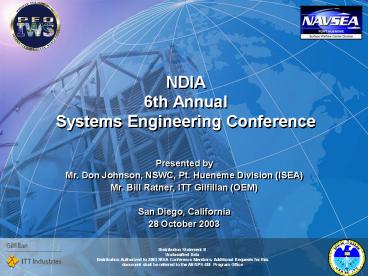NDIA 6th Annual Systems Engineering Conference - PowerPoint PPT Presentation
1 / 11
Title:
NDIA 6th Annual Systems Engineering Conference
Description:
Additional Requests for this document shall be referred to the AN/SPS-48E ... Legacy System used as a Gap Filler until other technologies are fielded. Page 7 ... – PowerPoint PPT presentation
Number of Views:26
Avg rating:3.0/5.0
Title: NDIA 6th Annual Systems Engineering Conference
1
NDIA6th Annual Systems Engineering Conference
- Presented by
- Mr. Don Johnson, NSWC, Pt. Hueneme Division
(ISEA) - Mr. Bill Ratner, ITT Gilfillan (OEM)
- San Diego, California
- 28 October 2003
2
Purpose of Presentation
- Show innovative tactics and lessons learned in
bringing current technologies to a legacy
system for improving its life cycle while
enhancing performance. - Focuses on the effort to improve the Life Cycle
of the AN/SPS-48E Radar by NAVSEA, NSWC OEM
3
Major Theme and Subsets
- AN/SPS-48E Mid Life Upgrade addresses emerging
threats to both Life Cycle and Mission
Capabilities. - Introduce solid-state amplifier technology to
replace the high power to Reduce impact of high
failure components in the transmitter - Introduce open architecture processing to address
the issue of unprocurable parts while ensuring
that future technology upgrades are made more
affordable - Address the immediate problem of diminishing
manufacturing sources - Provide enhanced radar performance and remote
diagnostic capability for reduced manning. - Reduce Ownership cost.
- Follow the radar roadmap
4
Tactics Lessons LearnedApproach
- Tactics Applied
- Open Discussion of Needs
- Benchmark to Roadmap
- Engage customers and end users
- Inventory Technology
- Focus on Value
- Establish Metrics to Measure Value
- Conduct Risk Assessment
- Lesson Learned
- Know what you want
- Know what you have
- Know your data
- Know how you are going to get what you what
- Follow the process
- Conduct Risk Assessment through a 3rd Party
- Inform Stakeholders
5
Technology Insertioninto Legacy Systems
- The Legacy AN/SPS-48E Radar 45 Units
- Primary Function
- 3D Air Surveillance
- Part of New Threat Upgrade Combat Suite
- Destroyers Cruisers
- In Service Date 1984
- Expanded role to all Carriers, including CVN77,
LHDs, LHAs, LPD17 Class Ships - Projected Service Life
- 2040 vs. planned 2005
6
Technology Insertioninto Legacy Systems
- AN/SPS-48Es role on the Radar Roadmap
- Legacy System used as a Gap Filler until other
technologies are fielded
7
Technology Insertioninto Legacy Systems
- Desired Outcome for supportability, maintenance
and performance - Improve RMA
- Reverse overall trend in A0
- 0.77 in FY-99
- 0.70 (Recent 12 Months)
- Take advantage of technology insertion/refresh
- Modular Architecture of 48E Radar allows for
timely modernization - Solid State for stability improvement
- Reducing Footprint
- Software Re-hosting
Radars Modular Design Enhances Technology
Insertion
Replacement Units Marked in Red Modified Units
Marked in Green
8
Technology Insertioninto Legacy Systems
- Technology Insertion Strategies
- Capture Hold Base
- Refurbishment Program
- Spares and Repairs
- Engineering Development Model
- Foreign Military Sales Programs
- Performance Modifications
- Diminished Industrial Capacity Survey
- NSWC, Crane Industry
- Capitalize on Business Base with Diminished
Capacity Focus - Technology fold over from all programs to reach
desired outcomes - Develop Business Model
- Have a 3rd Party Calculate ROI
Forecast of Diminished Capacity Caused by Unable
to Procure
9
Technology Insertioninto Legacy Systems
- Measuring desired outcomes
- Establish Goals
- RMA
- Reduce LRUs
- Improve MTBF
- Improve MTTR
- Reduce Training Time
- Capture Value Added
- Spider Diagram
10
Technology Insertioninto Legacy Systems
- Engaging Technology Insertion Process
- Start with a Core Group
- Establish Desired Outcomes
- Meet Periodically
- Establish Technology Goals
- Data Drive
- Listen to User Community
- TMI/TMA
- Workshops
- Listen to Sponsor Community
- NSWC
- NAVICP
- NAVSEA
- OPNAV
11
Technology Insertioninto Legacy Systems
- Review of Tactics Used for Technology Insertion
- Open Discussion of Needs
- Benchmark
- Engage customers and end users
- Inventory Technology
- Focus on Value
- Establish Metrics to Measure Value
- Conduct Risk Assessment
Core Technology
for Insertion
NRE Recurring for
Mod Kit
Insertion Technology
System Testing
and Design Verification
Fielded 48E Radars
Technology Insertion Concepts































